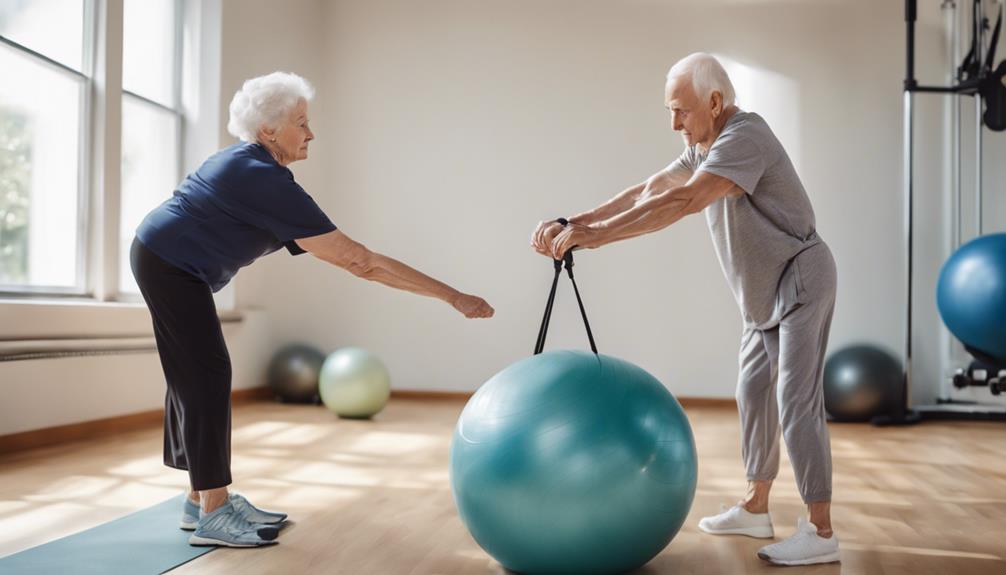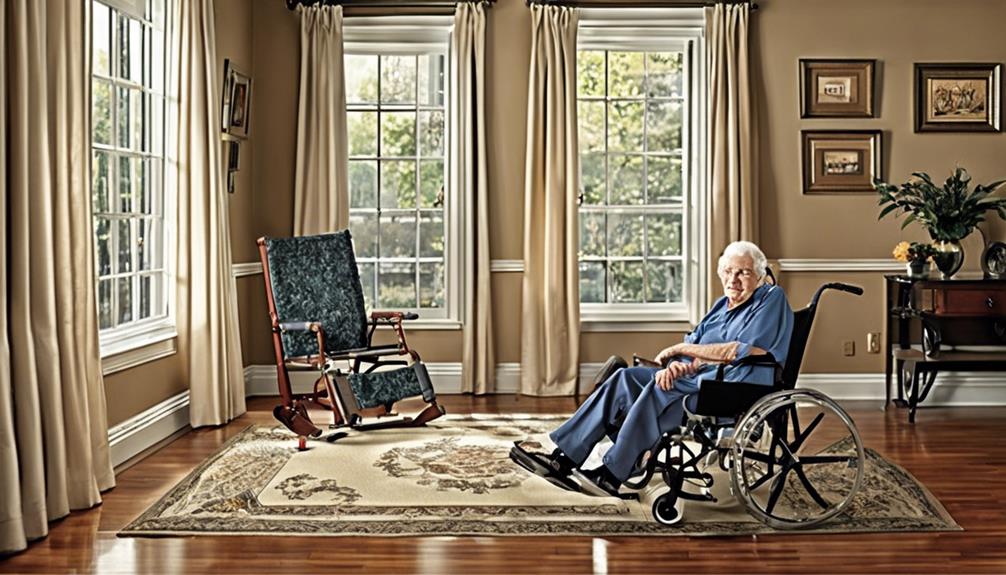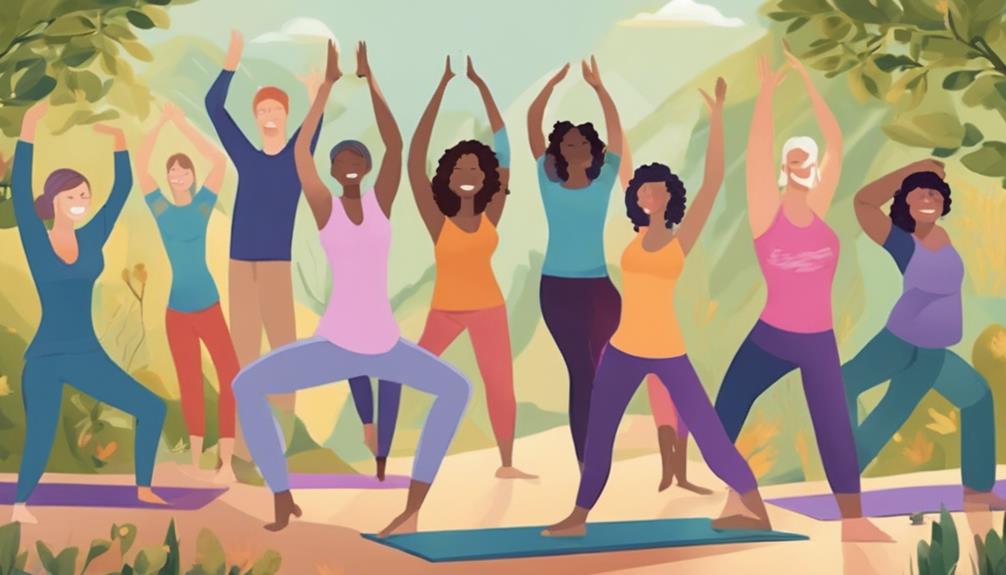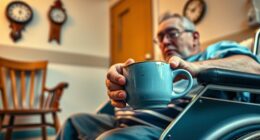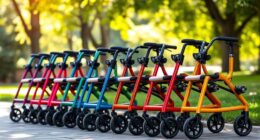To prevent falls in the elderly, it's important to take proactive steps. Enhance balance and strength through activities like walking or tai chi. Regular exercise boosts muscle strength and prevents weakness. Check medications for side effects like balance issues. Regular vision checks can address potential problems. Use safety features like non-slip mats and grab bars. Organize medications for safety with a pill organizer. Install safety features like good lighting and balance bars in the home. These strategies can help reduce fall risk in older adults to a great extent. Additional details on effective fall prevention methods are available in the research provided.
Key Takeaways
- Regular physical activity improves balance and strength.
- Medication reviews reduce fall risk from side effects.
- Vision checks correct issues that affect balance.
- Installing safety features like grab bars enhances stability.
- Organizing medications with pill organizers ensures proper dosage.
Importance of Fall Prevention
Understanding the vital importance of fall prevention is essential for safeguarding the well-being of older adults. Prevention is paramount when it comes to ensuring the safety and health of our elderly population.
Falls are a major concern, being the leading cause of fatal and non-fatal injuries among older adults. Every 11 seconds, an older adult is treated in the emergency room for a fall-related injury, highlighting the urgency of implementing fall prevention programs. These programs have shown to reduce the risk of falls by up to 30% in community-dwelling older adults.
Understanding Fall Risk Factors
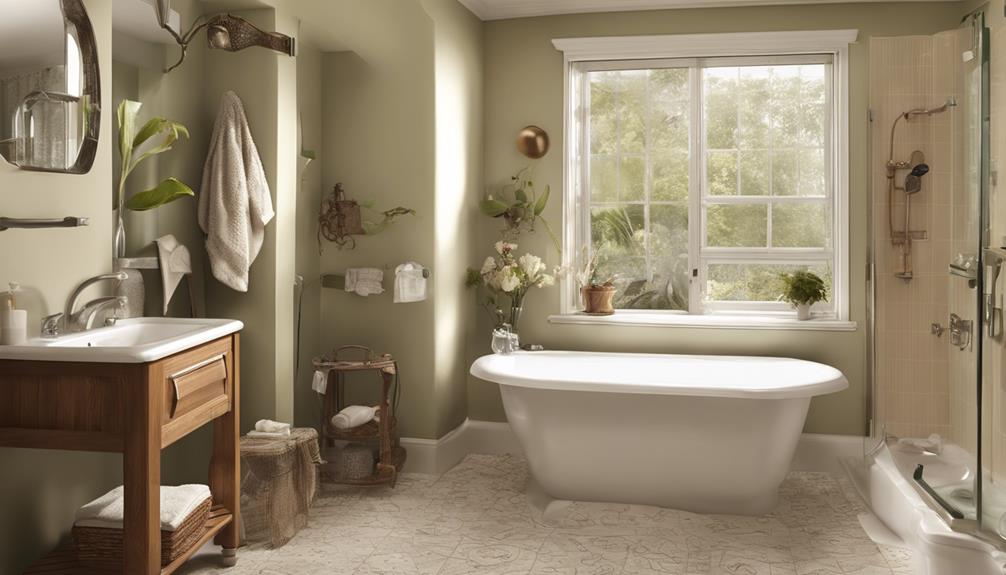
Identifying and addressing fall risk factors in the elderly requires a thorough evaluation of various physical and cognitive aspects that can contribute to the likelihood of falls. Factors such as balance problems, declining muscle strength, and vision issues play an important role in determining the risk of falling.
According to the National Institute on Aging, one in four older adults experiences a fall each year in the U.S., making fall prevention essential. To assess the risk of falling, it's important to have muscle strength, balance, and vision checked regularly. Conditions like sarcopenia and unsafe footwear can further increase the risk of falls in older adults.
Additionally, cognitive impairments and rushed movements due to certain health conditions can also elevate the likelihood of falling. By staying proactive and addressing these risk factors, we can help prevent falls and promote safety among the elderly population.
Promoting Physical Activity for Balance
To enhance balance and strength in older adults, promoting physical activity like walking or tai chi is essential. Engaging in regular exercise not only improves muscle strength but also helps prevent muscle weakness, reducing the risk of falls in the elderly.
Activities focusing on balance and flexibility, such as yoga, can enhance stability and coordination, further contributing to fall prevention. Additionally, incorporating strength training exercises like weight lifting into a routine can build muscle strength and improve mobility, enhancing overall stability.
It's recommended that older adults engage in physical activity for at least 150 minutes per week to maintain balance and reduce the likelihood of falls. By incorporating these various forms of physical activity into daily routines, older adults can significantly decrease their risk of falling and maintain their independence and quality of life.
Medication Review and Fall Prevention

When it comes to preventing falls in the elderly, it's important to pay close attention to the medications they're taking. Some medications can increase the risk of falls by affecting balance and coordination.
Medication Side Effects
Reviewing medications with a healthcare provider is crucial for reducing fall risk in older adults, as medication side effects play a significant role in falls in this population. To address this issue effectively, consider the following:
- Identify Sedatives and Antidepressants: These medications can increase the likelihood of falls due to their effects on balance and coordination.
- Watch for Polypharmacy: Taking multiple medications simultaneously can be a significant risk factor for falls in the elderly.
- Consider Medication Adjustments: Working with a healthcare provider to adjust dosages or switch medications can help minimize side effects that contribute to falls.
- Regular Monitoring: Regular check-ins with healthcare professionals can ensure that medications are optimized for safety and fall prevention.
Drug Interactions Risk
Identifying potential drug interactions is vital for mitigating fall risk in elderly individuals. Medication reviews play a significant role in preventing falls by identifying medications that could interact harmfully, leading to balance issues. Below is a table illustrating common drug interactions that can increase fall risk in the elderly:
| Medication Category | Potential Interaction |
|---|---|
| Sedatives | Increased dizziness |
| Antidepressants | Risk of confusion |
| Antihypertensives | Balance problems |
| Polypharmacy | Multiple interactions |
Understanding these interactions through medication reviews can help healthcare professionals adjust prescriptions to decrease the risk of falls. By being aware of how medications can affect each other, we can better protect our elderly loved ones from unnecessary harm.
Dosage Adjustments Importance
Understanding the significance of dosage adjustments in medication reviews is essential for preventing falls in the elderly. When it comes to medication-related issues and fall risk, dosage adjustments play an important role. Here's why dosage adjustments are significant in preventing falls:
- Reducing Side Effects: Adjusting dosages can help minimize side effects like dizziness or drowsiness, which are common causes of falls.
- Lowering Fall Risk: Older adults taking multiple medications are at a higher risk of falls, making dosage adjustments essential in mitigating this risk.
- Pharmacist Assistance: Pharmacists can identify medications that increase fall risk and recommend appropriate dosage changes.
- Healthcare Provider Collaboration: Regularly reviewing medications with healthcare providers can enhance the management of drug interactions and potential fall hazards.
Vision Checks for Fall Prevention

Regular vision checks play an important role in preventing falls among the elderly by identifying and addressing potential vision problems that can increase the risk of accidents. Visual impairment is a significant risk factor for falls in older adults. Poor vision can lead to misjudging distances, tripping over objects, and missing obstacles, all of which contribute to falls. Correcting vision problems through glasses, contacts, or surgery can improve balance and reduce the likelihood of falls. Ensuring good vision is essential for maintaining independence and preventing accidents in older adults.
| Benefits of Vision Checks for Fall Prevention | ||
|---|---|---|
| Identifies potential vision problems | Addresses issues before they lead to falls | Improves balance and reduces fall risk |
Regular vision checks not only help in maintaining good eyesight but also play a crucial role in ensuring the safety and well-being of the elderly population. By addressing vision problems promptly, we can significantly decrease the chances of falls, promoting independence and a better quality of life for our older adults.
Home Safety Modifications

When it comes to making our homes safer for the elderly, simple modifications can make a big difference. Installing grab bars near toilets and tubs provides stability and support, reducing the risk of falls in the bathroom.
Adding non-slip mats or strips on wet surfaces is another effective way to prevent slips and falls in high-risk areas.
Grab Bars Installation
To enhance bathroom safety for seniors and reduce the risk of falls, installing grab bars in key locations is vital. Here are some important facts to ponder when installing grab bars:
- Placement: Install grab bars near toilets and tubs, where seniors may need additional support.
- Anchoring: Guarantee grab bars are securely anchored to wall studs to provide reliable support.
- Weight Capacity: Select grab bars that can support the weight of an individual to be effective in preventing falls.
- Effectiveness: Research indicates that strategically placed grab bars greatly reduce the likelihood of falls and injuries in seniors.
Non-Slip Flooring Mats
How can non-slip flooring mats greatly enhance home safety for the elderly? Non-slip mats are essential in reducing the risk of falls by providing traction on slippery surfaces commonly found in bathrooms and kitchens. These mats offer stability near sinks, showers, and bathtubs, areas prone to wetness. They are easy to install and come in various sizes to fit different spaces in the home. Non-slip flooring mats are cost-effective safety solutions that support elderly individuals in moving confidently without the fear of slipping. By using these mats, seniors can navigate their homes securely, preventing accidents and enhancing overall safety. Check out the table below for a quick overview:
| Benefits | Easy to Install | Cost-Effective |
|---|---|---|
| Reduces Fall Risk | Fits Different Spaces | Offers Stability |
Using Non-Slip Mats

By integrating non-slip mats into key areas of the home, we can significantly reduce the risk of falls for elderly individuals. Here are some important points to keep in mind when utilizing non-slip mats:
- Placement in High-Risk Areas:
Install non-slip mats in locations like bathrooms where falls in older adults are more prevalent. These mats provide secure footing, especially in wet areas, decreasing the chances of accidents.
- Textured Surface:
Non-slip mats come with a textured surface that improves traction, offering better grip on slippery floors. This feature is essential in preventing slips and falls, especially for seniors with decreased stability.
- Versatile Solutions:
Non-slip mats are available in various sizes and designs to fit different areas of the home. Placing them near bathtubs, showers, and sinks can effectively enhance elderly safety by reducing the risk of falls.
- Cost-Effective Safety:
Using non-slip mats is an affordable and straightforward way to enhance safety and stability for seniors during their daily activities. These mats are practical tools for preventing falls and promoting independence in older adults.
Supporting Elderly Loved Ones

Let's make sure to support our elderly loved ones by making their homes safer with modifications like grab bars and non-slip mats. Regular vision checks are also important to address any eyesight issues that could increase their risk of falling.
Engaging in physical therapy exercises together, such as tai chi or supervised programs, can help improve their balance and overall strength.
Home Safety Modifications
To improve the safety of elderly loved ones at home, consider implementing essential modifications to prevent falls. These adjustments are recommended by the National Institute on Aging (NIA) to create a secure environment for seniors: Install grab bars in the bathroom, secure loose rugs, and ensure adequate lighting in hallways and staircases. It’s also essential to rearrange furniture to create clear pathways and reduce tripping hazards. These practical steps, along with adopting defying human aging strategies like regular physical activity and maintaining balance, contribute significantly to enhancing both safety and quality of life for aging individuals.
- Install grab bars near toilets and tubs to reduce the risk of falls in the bathroom.
- Use nonskid mats or strips on wet bathroom surfaces to prevent slips and falls.
- Keep a night light on or use automatic night lights in the bathroom for improved visibility and safety.
- Place night lights and switches near the bed in the bedroom to assist elderly individuals in moving around the space at night.
Regular Vision Checks
Considering the importance of maintaining ideal vision for preventing falls in the elderly, prioritizing routine vision checks becomes a key strategy in supporting the safety and well-being of our aging loved ones. Vision problems can greatly increase the risk of falls among the elderly, making it essential to make sure their eyesight is in optimal condition. Encouraging regular eye exams for our elderly relatives can help detect any vision issues early on, reducing the chances of falling accidents. Here is a table highlighting the importance of vision checks in preventing falls:
| Vision Checks | Benefits |
|---|---|
| Early Detection | Identify vision problems |
| Improved Safety | Reduce fall risk |
| Enhanced Well-being | Ensure ideal eyesight |
| Preventative Care | Address issues promptly |
| Peace of Mind | Support overall health |
Physical Therapy Exercises
Engaging in personalized physical therapy exercises can greatly enhance the balance, strength, and flexibility of elderly individuals. These exercises are tailored to individual needs and abilities, focusing on improving mobility and reducing fall risk.
Regular physical therapy sessions help elderly loved ones maintain independence by providing guidance on proper form and technique from trained professionals. Incorporating a variety of exercises such as squats, lunges, and balance drills can improve overall physical function in the elderly population.
Organizing Medications for Safety

Properly organizing medications is essential for ensuring the safety and well-being of elderly individuals. To prevent medication errors and potential falls, it's important to keep medications in a pill organizer with clearly labeled compartments. This helps guarantee that doses are taken correctly and at the right time. Additionally, maintaining a medication schedule or list can assist in tracking doses and avoiding any missed or doubled medications.
Organizing medications based on the time of day or their purpose can streamline the process and reduce the risk of confusion. It's crucial to store medications in a safe and accessible location. Proper storage not only prevents medication mix-ups but also reduces the chances of falls when reaching for or taking medications. By following these organizing practices, caregivers can help elderly individuals manage their medications effectively and safely, promoting overall health and well-being.
Installing Safety Features
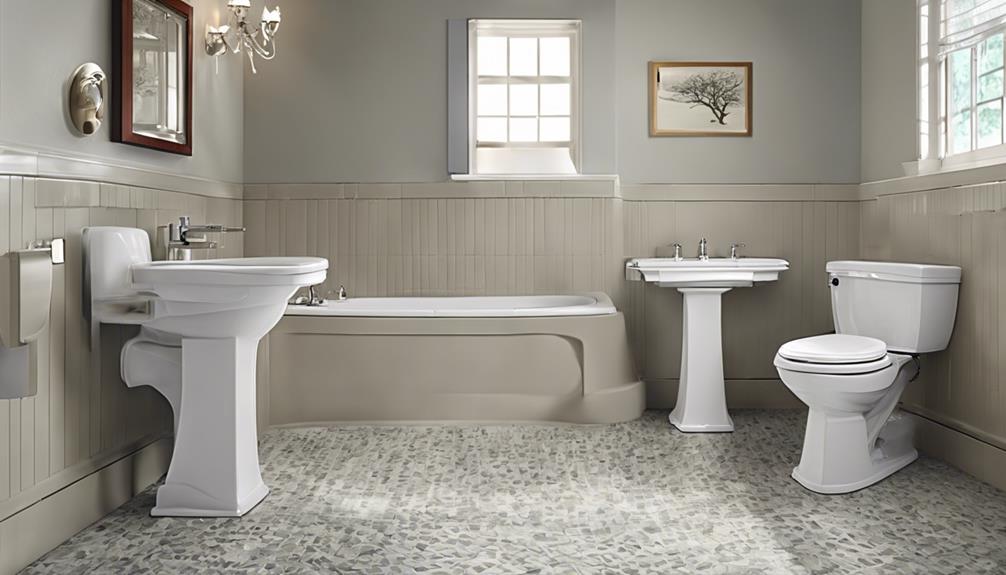
To enhance safety and prevent falls in the elderly, we recommend installing grab bars near toilets and tubs as an essential measure. Here are some key safety features to take into account:
- Grab Bars: Installing grab bars near toilets and tubs provides stability and support for seniors when using these facilities, reducing the risk of falls.
- Nonskid Mats: Placing nonskid mats or strips on wet bathroom surfaces can help prevent slips and falls by creating a secure footing even in slippery conditions.
- Night Lights: Adding proper lighting, such as night lights or automatic night lights in the bathroom, enhances visibility during nighttime visits, reducing the chances of accidents.
- Good Lighting: Ensuring good overall lighting and easy access to light switches in the bathroom is vital for fall prevention as it helps seniors see clearly and navigate safely.
Additionally, mounting balance bars near entrances and exits can aid older adults in maintaining their balance outdoors, further minimizing the risk of falls. By incorporating these safety features, you can create a safer environment for the elderly to move around confidently.
Frequently Asked Questions
What Are the 5 P's of Fall Prevention?
When it comes to fall prevention, the 5 P's are essential: Physical activity, Proper footwear, Prevention of home hazards, Prescription medication review, and Vision checks. These steps help reduce risks and enhance safety for seniors.
What Are the 4 P's of Fall Prevention?
Identify risks, plan safe strategies, use assistive devices, involve caregivers – those are key to fall prevention. Let's guarantee a secure environment for loved ones. Our proactive measures keep them safe.
What Do I Do if My Elderly Parent Keeps Falling?
If our elderly parent keeps falling, we must address this issue promptly. Assess risk factors, encourage exercise, create a safe environment, attend medical appointments, and monitor health changes closely. Taking proactive steps can help prevent future falls.
Why Does My 89 Year Old Keep Falling?
We acknowledge the concern about recurrent falls in an 89-year-old. It is crucial to identify underlying causes such as vision changes, balance issues, and muscle weakness. Seeking advice from a healthcare professional can assist in determining the most effective prevention strategies.
Conclusion
To sum up, preventing falls in the elderly is like building a strong fortress around a precious treasure.
By understanding the risk factors, promoting physical activity, reviewing medications, checking vision, and using non-slip mats, we can create a safe environment for our seniors.
Supporting loved ones, organizing medications, and installing safety features are also crucial steps in preventing falls among the elderly.
With these measures in place, we can help our elderly loved ones stay independent and safe for years to come.
